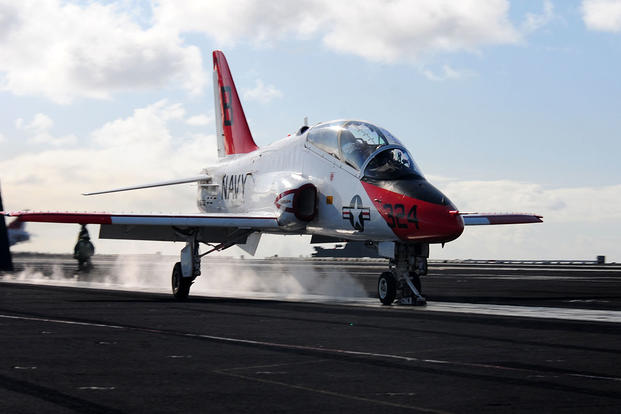NATIONAL HARBOR, Maryland -- The Navy's director of air warfare said the decision by numerous instructor pilots not to fly the T-45 Goshawk trainer amid concerns over cockpit oxygen generation systems may reflect a lack of information about how much the service is doing to address the problem.
Rear Adm. DeWolfe Miller told Military.com that experts have been "swarming" three training bases in Meridian, Mississippi; Pensacola, Florida; and Kingsville, Texas, where about 40 percent of T-45 flights were canceled March 31 when instructor pilots cited operational risk management concerns.
At the root of the issue is a spike in reported physiological episodes akin to hypoxia, with 10 T-45 cockpit incidents in the last month alone, according to an explosive Fox News report.
"I think what happened is we didn't communicate to the aircrew, to the instructor pilots of our T-45s and their three bases the level of effort that we've been putting forth toward trying to solve this issue," Miller said. "And so we sent a team down there over the last couple days. We sent these guys down now to educate and inform the instructor pilots, 'Here's what we're doing, and what about your situation.' "
The Navy announced Wednesday that all 197 T-45s would spend three days on the ground while the service conducts a safety stand-down to address the issue. Miller noted that the Navy had already been collecting cockpit air samples via Sorbent tubes and changed out air filters to improve the quality of cockpit oxygen.
A source quoted by Fox took a dimmer view of the Navy's efforts, however, saying one squadron had received only six of the tubes. And tests remained inconclusive even after air samples from 1,500 flights were screened, according to the report.
But while one flight instructor and student ejected from their aircraft and let it crash after experiencing a cockpit episode last August, Miller downplayed the severity of the majority of reported incidents.
"We have procedures that if you get an indication that you have an [onboard oxygen generation system] degrade, you turn off the [OBOGS], you use your emergency oxygen, and we descend to an altitude where the breathing air is good and you land the airplane," he said. "We have done that, pilots are trained on how to do that, and that procedure is working well."
While a safety stand-down was called for, he said he didn't expect the Navy to ground T-45s for any extended period of time.
"It's not happening at a rate that we just stop flying," he said.
Acting Secretary of the Navy Sean Stackley told Military.com on Wednesday that there are a lot of potentially causal factors in play, adding that the service previously contended with cockpit physiological episodes in the F/A-18 Super Hornet.
"So it's going to take a long time to work our way down," he said. "If it's this many things that are contributing to the problem, you work your way down and get it to the de minimis stage. It's not going to be one single thing that solves the problem. It is taking time to identify the fixes and get them implemented, and then measuring the results."
In the meantime, Stackley said, the Navy is redoubling efforts to collect accurate and specific data from pilots about the different kinds of episodes and symptoms, to help in determining the right fix.
"We have been trying to capture the experience, the episodes, so we can get down at the root of what's causing them," he said. "So when the pilots come back, we're going to go after data we've never captured before as far as the physiological part, him or herself ... it's a pretty extensive analytical effort to run these causes to ground."
Miller said he expects improved communication between Navy brass and instructor pilots to result in greater confidence for the aviators.
"Over the next couple of days, my expectation is we're back in the air, we're flying, and guys will feel more confident knowing that leadership is listening and doing something about the issue," he said.
-- Hope Hodge Seck can be reached at hope.seck@military.com. Follow her on Twitter at@HopeSeck.































